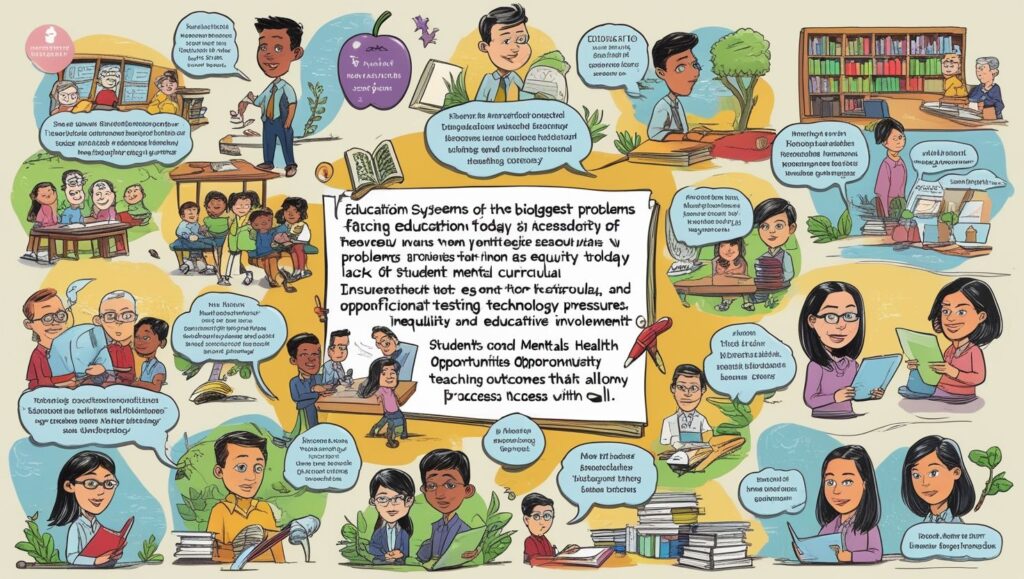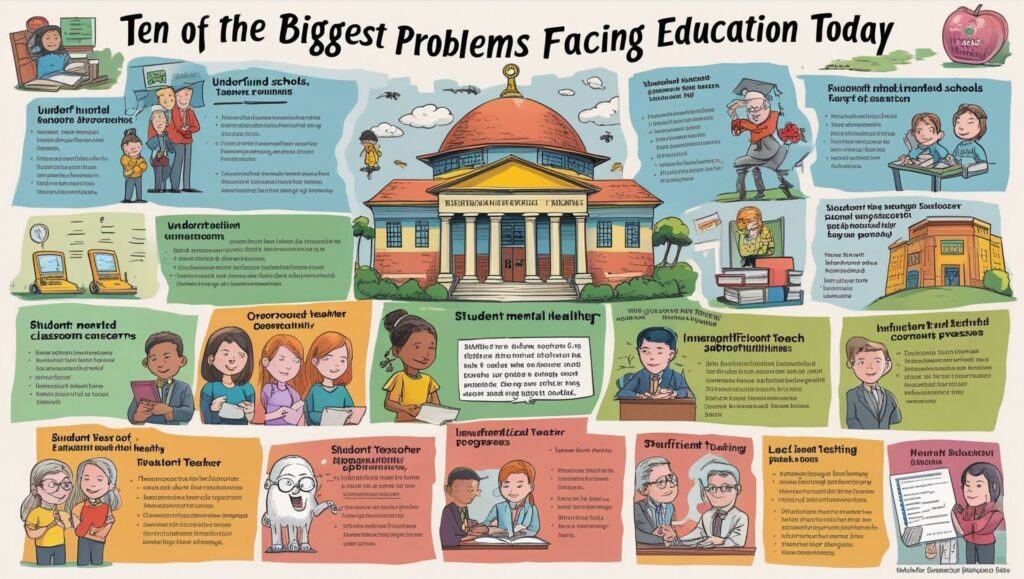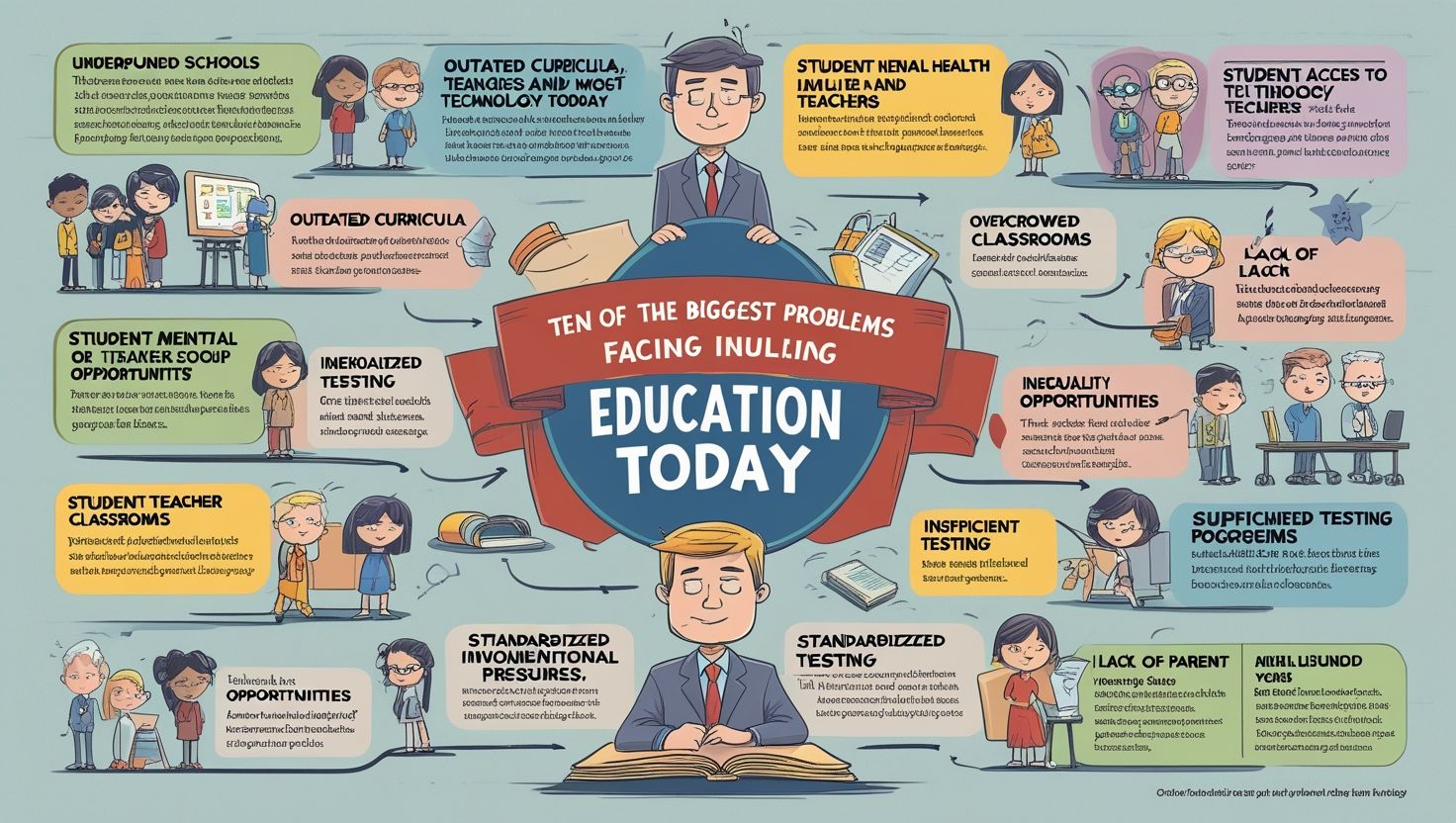Ten of the Biggest Problems Facing Education Today, Education is a fundamental human right, yet millions of children worldwide face barriers that prevent them from accessing quality schooling. From violence in classrooms to systemic inequalities, these challenges hinder learning and development. Below are ten of the most pressing issues in education today, each discussed in detail.
1. Conflict and Violence
Conflict and violence severely disrupt education. In war-torn regions, schools are often destroyed or occupied by armed groups. Consequently, children miss years of schooling. Additionally, families fleeing violence become displaced, making education inaccessible. Even in stable countries, political unrest can lead to frequent school closures.
Moreover, conflict creates long-term psychological trauma. Students exposed to violence struggle to concentrate and perform academically. Governments and NGOs must prioritize safe learning spaces in crisis zones. Temporary schools and online learning can help, but sustainable peace is essential.
Furthermore, rebuilding education post-conflict is costly. Infrastructure, teacher training, and curricula must be restored. Without intervention, generations may remain uneducated, perpetuating poverty. Therefore, international cooperation is crucial to protect education in conflict areas.
2. Violence and Bullying in the Classroom
Violence and bullying in schools create unsafe learning environments. Physical fights, verbal abuse, and cyberbullying affect students’ mental health. As a result, many victims skip school or drop out entirely. Teachers often lack training to handle such issues effectively.
Additionally, bullying leads to poor academic performance. Students who fear harassment cannot focus on studies. Schools must enforce strict anti-bullying policies. Peer mediation and counseling programs can also help.
Furthermore, societal violence spills into schools. Gang activity and weapon possession increase risks. Metal detectors and security personnel may be necessary, but fostering respect and empathy is more sustainable. Parents, teachers, and students must work together to create safer schools.

3. Climate Change
Climate change disrupts education in multiple ways. Natural disasters like floods and hurricanes destroy school buildings. Consequently, students lose learning time. In drought-prone areas, children leave school to fetch water, missing classes.
Moreover, extreme heat makes classrooms unbearable. Without proper ventilation, concentration drops. Schools in vulnerable regions need climate-resilient infrastructure. Governments should invest in renewable energy and disaster preparedness.
Additionally, climate-related migration affects education. Families moving due to environmental crises often struggle to enroll children in new schools. Global policies must ensure displaced students continue their education uninterrupted.
4. Harvest Seasons and Market Days
In rural communities, harvest seasons and market days pull children out of school. Families depend on child labor for survival. As a result, attendance drops during planting and harvesting periods.
Furthermore, poverty forces children to work instead of studying. Even if schools are free, lost wages make education unaffordable. Flexible school schedules could help, allowing children to work and study.
Governments should also provide financial incentives for families to keep children in school. Conditional cash transfers have proven effective in some regions. Without such interventions, child labor will continue to hinder education.
5. Unpaid and Underqualified Teachers
Unpaid or underpaid teachers struggle to deliver quality education. Many work in poor conditions without proper training. Consequently, student learning suffers. In some countries, teachers go on strike, disrupting schooling.
Additionally, underqualified teachers lack modern teaching skills. Outdated methods fail to engage students. Governments must invest in teacher training and fair wages. Motivated teachers improve student outcomes significantly.
Moreover, teacher shortages worsen the problem. Overcrowded classrooms reduce individual attention. Recruiting and retaining skilled educators should be a top priority for education systems worldwide.

6. The Cost of Supplies and Uniforms
Many families cannot afford school supplies and uniforms. Even if tuition is free, additional costs create barriers. As a result, children from low-income households drop out.
Furthermore, uniforms are often mandatory. Without them, students face discrimination. Governments and charities should provide free uniforms and materials to reduce financial burdens.
Additionally, digital learning requires devices many cannot afford. Bridging this gap is essential for equitable education. Subsidies and donation programs can help underprivileged students stay in school.
7. Being an Older Student
Older students, especially those returning after dropping out, face stigma. They may feel out of place among younger peers. Consequently, many abandon education altogether.
Moreover, adult learners often balance work and studies. Flexible learning options, like night schools or online courses, can help. Governments should promote lifelong learning opportunities.
Additionally, older students may lack foundational skills. Remedial programs can bridge gaps, ensuring they succeed academically.
8. Being Female
In many regions, girls face significant educational barriers. Early marriage and pregnancy force many to drop out. Cultural norms often prioritize boys’ education over girls’.
Furthermore, lack of sanitary facilities keeps girls home during menstruation. Schools must provide hygiene products and private bathrooms to improve attendance.
Additionally, gender-based violence deters girls from attending school. Safe transportation and female teachers can encourage enrollment. Empowering girls through education benefits entire communities.
Conclusion
Education systems worldwide face numerous challenges. From violence and climate change to gender inequality, these issues require urgent attention. Governments, NGOs, and communities must collaborate to create inclusive, safe, and sustainable learning environments. Only then can every child access the education they deserve.

This article hits the mark on blending creativity with tech-tools like Lovart show how AI can streamline design without losing the human touch. Great insights for modern creators.
開元棋牌KYONLINE- 台灣最佳娛樂城
免費註冊 三秒遊玩 十秒中獎
海量線上老虎機 漁機 棋牌遊戲等玩家來解鎖遊玩
開元棋牌完全免費
立即點開抽取iphone以及多樣吸引人的獎品
開元娛樂城
Everything is very open and very clear explanation of issues. was truly information. Your website is very useful. Thanks for sharing.
Aftrr checking out a handful of the blog poets on your web page, I honestly like your tchnique of writing a blog.
I added it to my bookmark website list and will be checking back soon. Take
a look at my webite too and let me kknow how you feel. https://Glassiindia.wordpress.com/
Hawkplay – Уou can Use GCash to play in anytime
Free Spins 1000+ Free Demo Slot
Openning Bonus 120% piso ƅack
Searching hawkplay casino ᧐n Google or Bing tߋ ցet free coins
hawkplay
Hi my family member! I want to say that this post is amazing, nice written and include approximately all important infos. I’d like to look more posts like this.
Magnificent website. Plenty of useful information here. I am sending it to some friends ans also sharing in delicious. And of course, thanks for your effort!
Эта статья предлагает захватывающий и полезный контент, который привлечет внимание широкого круга читателей. Мы постараемся представить тебе идеи, которые вдохновят вас на изменения в жизни и предоставят практические решения для повседневных вопросов. Читайте и вдохновляйтесь!
Ознакомиться с деталями – https://vivod-iz-zapoya-1.ru/
Pretty section of content. I just stumbled upon your blog and in accession capital to assert that I get actually enjoyed account your blog posts. Any way I’ll be subscribing to your feeds and even I achievement you access consistently fast.
Certainly. And I have faced it. Let’s discuss this question. Here or in PM.
I discovered your weblog site on google and verify just a few of your early posts. Proceed to maintain up the very good operate. I simply further up your RSS feed to my MSN News Reader.
Hello there I am so delighted I found your weblog, I really found you by mistake, while I was searching on Google for something else, Anyhow I am here now and would just like to say cheers for a remarkable post and a all round exciting blog (I also love the theme/design), I don’t have time to browse it all at the moment but I have book-marked it and also included your RSS feeds, so when I have time I will be back to read a lot more, Please do keep up the superb work.
These stories are so important.
Does it look like we’re in for a big ride here?
thank, I thoroughly enjoyed reading your article. I really appreciate your wonderful knowledge and the time you put into educating the rest of us.
Good job for bringing something important to the internet!
Our community leaders need to read this, and look at developing some of your recommendations.
Nice blog. Could someone with little experience do it, and add updates without messing it up? Good information on here, very informative.
Its wonderful as your other blog posts : D, regards for putting up.